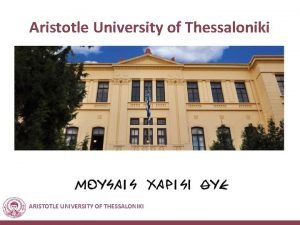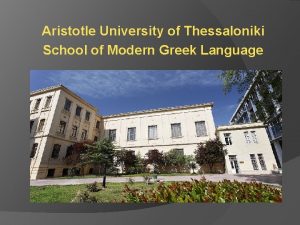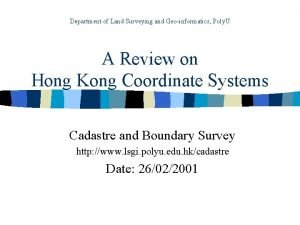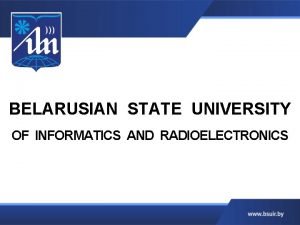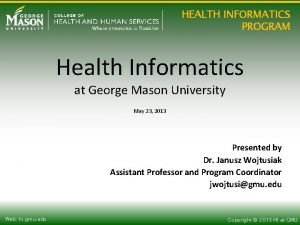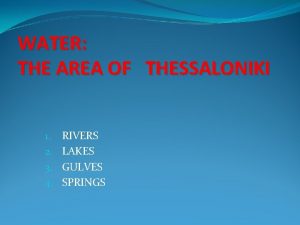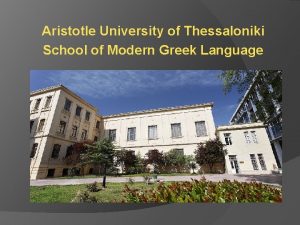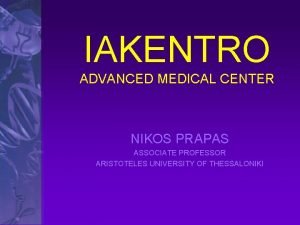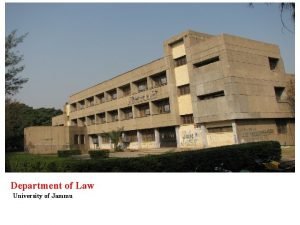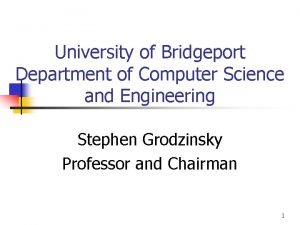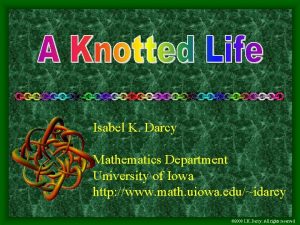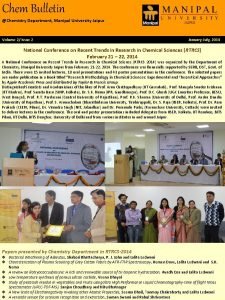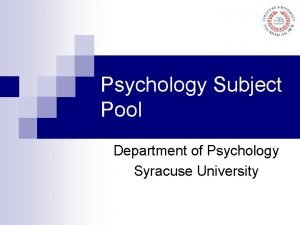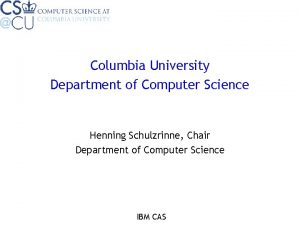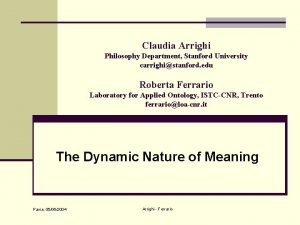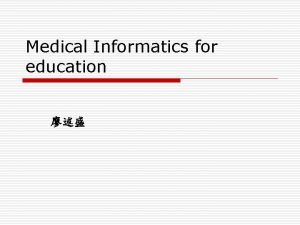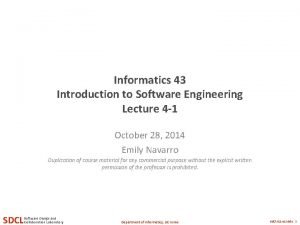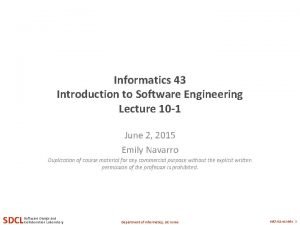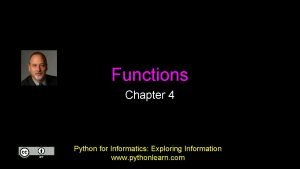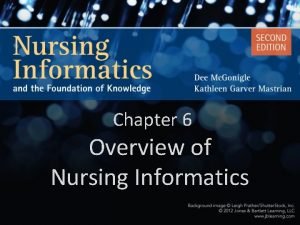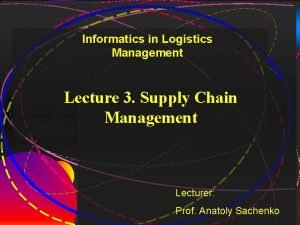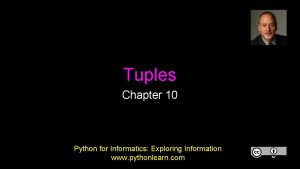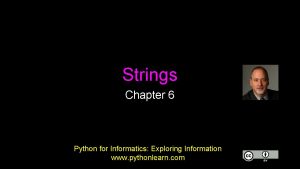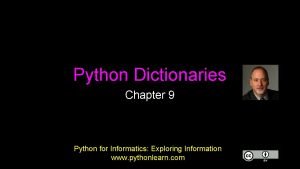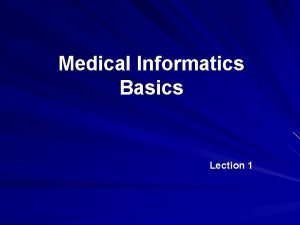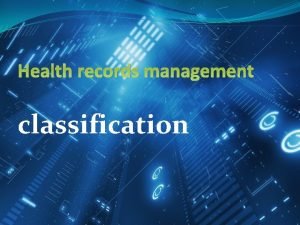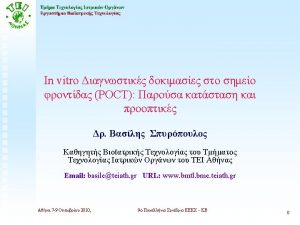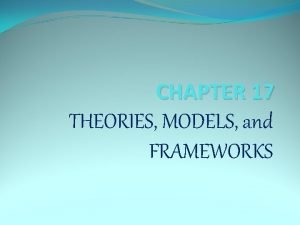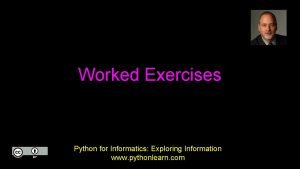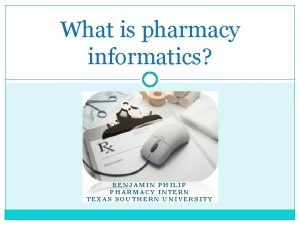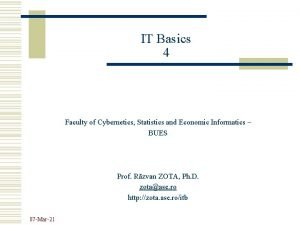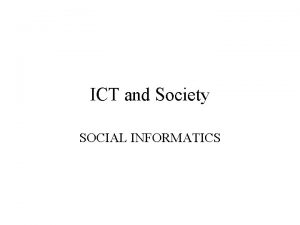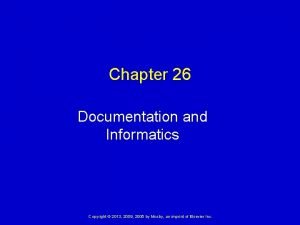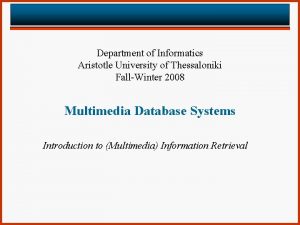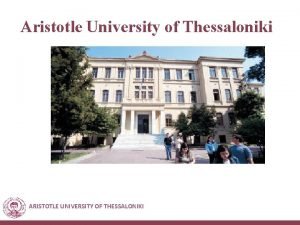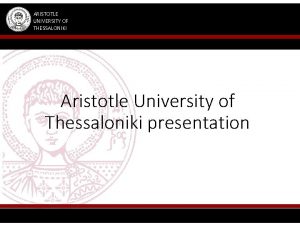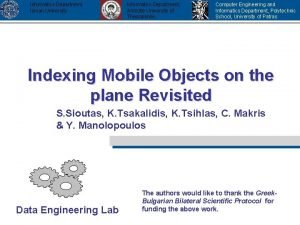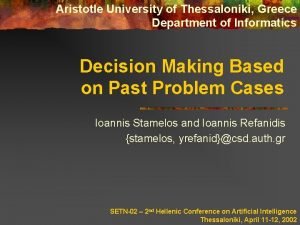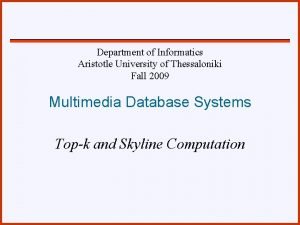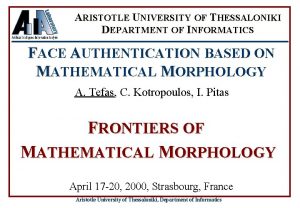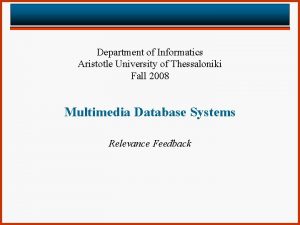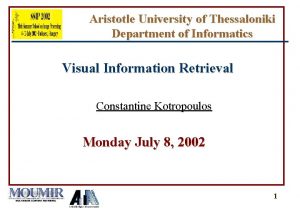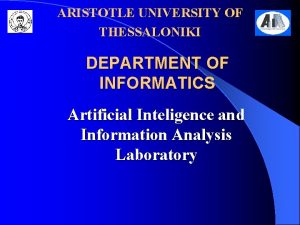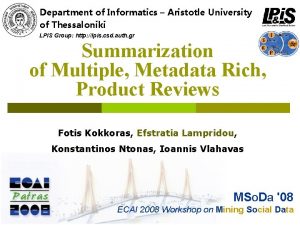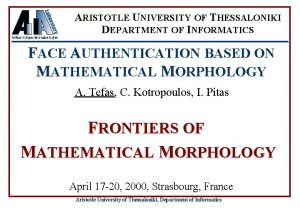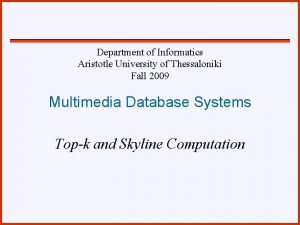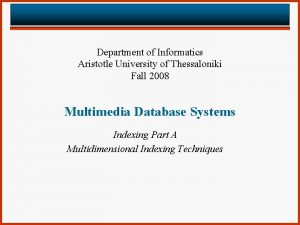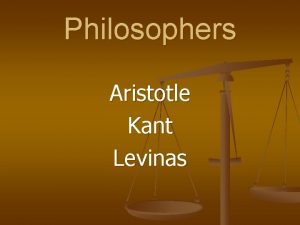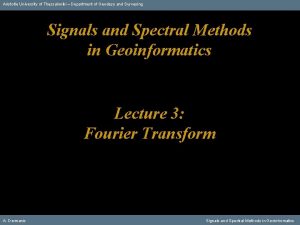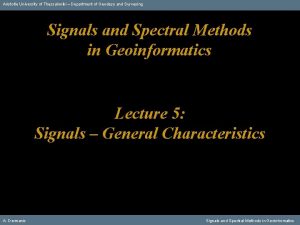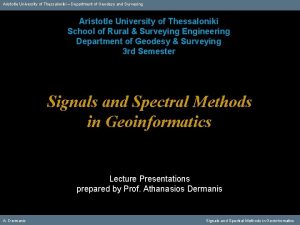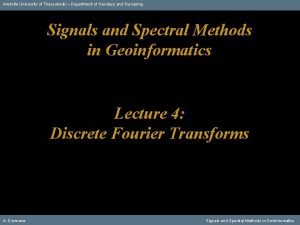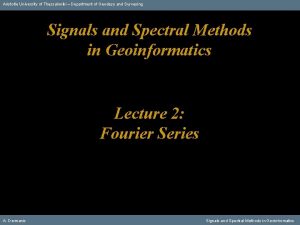Department of Informatics Aristotle University of Thessaloniki FallWinter





















































- Slides: 53

Department of Informatics Aristotle University of Thessaloniki Fall-Winter 2008 Multimedia Database Systems Retrieval by Content

MIR Motivation Large volumes of data world-wide are not only based on text: Ø Satellite images (oil spill), deep space images (NASA) Ø Medical images (X-rays, MRI scans) Ø Music files (mp 3, MIDI) Ø Video archives (youtube) Ø Time series (earthquake measurements) Question: how can we organize this data to search for information? E. g. , Give me music files that sound like the file “query. mp 3” Give me images that look like the image “query. jpg” 2

MIR Motivation One of the approaches used to handle multimedia objects is to exploit research performed in classic IR. Each multimedia object is annotated by using freetext or controlled vocabulary. Similarity between two objects is determined as the similarity between their textual description. 3

MIR Challenges Ø Multimedia objects are usually large in size. Ø Objects do not have a common representation (e. g. , an image is totally different than a music file). Ø Similarity between two objects is subjective and therefore objectivity emerges. Ø Indexing schemes are required to speed up search, to avoid scanning the whole collection. Ø The proposed techniques must be effective (achieve high recall and high precision if possible). 4

MIR Fundamentals In MIR, the user information need is expressed by an object Q (in classic IR, Q is a set of keywords). Q may be an image, a video segment, an audio file. The MIR system should determine objects that are similar to Q. Since the notion of similarity is rather subjective, we must have a function S(Q, X), where Q is the query object and X is an object in the collection. The value of S(Q, X) expresses the degree of similarity between Q and X. 5

MIR Fundamentals Queries posed to an MIR system are called similarity queries, because the aim is to detect similar objects with respect to a given query object. Exact match is not very common in multimedia data. There are two basic types of similarity queries: Ø A range query is defined by a query object Q and a distance r and the answer is composed of all objects X satisfying S(Q, X) <= r. Ø A k-nearest-neighbor query is defined by an object Q and an integer k and the answer is composed of the k objects that are closer to Q than any other object. 6

MIR Fundamentals Similarity queries in 2 -D Euclidean space k=3 Q r range query Q k-NN query 7

MIR Fundamentals Given a collection of multimedia objects, the ranking function S( ), the type of query (range or k-NN) and the query object Q, the brute-force method to answer the query is: Brute-Force Query Processing [Step 1] Select the next object X from the collection [Step 2] Test if X satisfies the query constraints [Step 3] If YES then report X as part of the answer [Step 4] GOTO Step 1 8

MIR Fundamentals Problems with the brute-force method Ø The whole collection is being accessed, increasing computational as well as I/O costs. Ø The complexity of the processing algorithm is independent of the query (i. e. , O(n) objects will be scanned). Ø The calculation of the function S( ) is usually time consuming and S( ) is evaluated for ALL objects, the overall running time increases. Ø Objects are being processed in their raw form without any intermediate representation. Since multimedia objects are usually large in size, memory problems arise. 9

MIR Fundamentals Multimedia objects are rich in content. To enable efficient query processing, objects are usually transformed to another more convenient representation. Each object X in the original collection is transformed to another object T(X) which has a simpler representation than X. The transformation used depends on the type of multimedia objects. Therefore, different transformations are used for images, audio files and videos. The transformation process is related to feature extraction. Features are important object characteristics that have large discriminating power (can differentiate one object from another). 10

MIR Fundamentals Image Retrieval: paintings could be searched by artists, genre, style, color etc. 11

MIR Fundamentals Satellite images – for analysis/prediction 12

MIR Fundamentals Audio Retrieval by content: e. g, music information retrieval. 13

MIR Fundamentals Each multimedia object (text, image, audio, video) is represented as a point (or set of points) in a multidimensional space. 14

Image Retrieval Using Annotations Ø Problem of image annotation – Large volumes of databases – Valid only for one language – with image retrieval this limitation should not exist Ø Problem of human perception – Subjectivity of human perception – Too much responsibility on the end-user Ø Problem of deeper (abstract) needs – Queries that cannot be described at all, but tap into the visual features of images. 15

Image Retrieval Using Annotations young lady or old lady ? Can you annotate these images? 16

Image Retrieval Using Annotations Can you annotate this image? 17

Image Retrieval By Content There are three important image characteristics: Ø Color Ø Texture Ø Shape Although each can be used by itself, two images that have similar colors, similar textures and depict similar shapes, are considered similar. The determination of similar images is called Image Retrieval By Content. 18

Image Retrieval By Content Major modules 19

Image Retrieval By Content Some systems Ø QBIC, IBM Almaden, 1993. Ø CANDID, Los Alamos National Laboratory, 1995. Ø Berkeley Digital Library Project, University of California @ Berkeley, 1996. Ø FOCUS, University of Massachusetts @ Amherst, 1997. Ø MARS, University of Illinois @ Urbana-Champaign, 1997. Ø Blobworld, University of California @ Berkeley, 1999. Ø C-Bird, Simor Fraser University, 1998. 20

Color Features Ø Examining images based on the colors they contain is one of the most widely used techniques because it does not depend on image size or orientation. Ø Color searches will usually involve comparing color histograms, though this is not the only technique in practice. Image Corresponding histogram 21

Color Features Ø The histogram of an image counts the number of pixels containing a specific color. For truecolor images the RGB space is mapped to 1 -D space. Ø To avoid a large number of colors (>16 M) quantization is used. Ø The dissimilarity between a query image Q and a DB image X corresponds to the distance between the histograms HQ and HX. 22

Color Features The distance between two histograms can be calculated by various distance measures such as: Histogram Intersection Euclidean Distance (L 2) Bhattacharyya Distance Matusita Distance Divergence Note: HQ(i) is the i-th histogram position. 23

Color Features The previous measures assume that two colors are independent. Therefore, small color differences may increase the dissimilarity of two images. To tackle this problem the Quadratic-Form distance functions have been proposed. D (Q, X) = (HQ – HX)TA (HQ – HX) color similarity matrix 24

Texture Features Texture measures look for visual patterns in images and how they are spatially defined. Textures are represented by texels which are then placed into a number of sets, depending on how many textures are detected in the image. These sets not only define the texture, but also the texture location in the image. Examples of different textures 25

Texture Features Ø Texture – innate property of all surfaces – Clouds, trees, bricks, hair etc… Ø Refers to visual patterns of homogeneity. Ø Does not result from presence of a single color. Ø Most accepted classification of textures based on psychology studies – Tamura representation: Coarseness Contrast Directionality Line-likeness most important Regularity Roughness 26

Texture Features The most commonly used texture representation is the texture histogram or texture description vector, which is a vector of numbers that summarizes the texture in a given image or image region. Usually, the first three texture features (i. e. , Coarseness, Contrast, Directionality) are used to generate the texture histogram. Texture dissimilarity is calculated by applying an appropriate distance function (e. g. , divergence). 27

Shape Features Ø Shape does not refer to the shape of an image but to the shape of a particular region. Ø Shapes will often be determined by first applying segmentation or edge detection to an image. Ø In some cases accurate shape detection will require human intervention, but this should be avoided. Ø Popular methods: projection matching, boundary matching. 28

Shape Features 29

Shape Features Ø Boundary Matching algorithms require the extraction and representation of the boundaries of the query shape and image shape. Ø The boundary can be represented as a sequence of pixels or maybe approximated by a polygon. Ø For a sequence of pixels, one classical matching technique uses Fourier descriptors to compare two shapes. 30

Shape Features From this sequence of points a sequence of unit vectors and a sequence of cumulative differences can be computed unit vectors cumulative differences 31

Shape Features Ø The Fourier descriptors {a-M, …, a 0, …, a. M} are then approximated by Ø These descriptors can be used to define a shape distance measure. 32

Image Similarity Computation Ø From color, texture and shape features a single vector VX can be produced for image X, and a single function S(VQ, VX) is used to compute similarity. Ø Alternatively, each image X is scored separately for color, texture and shape similarity with respect to the query Q. Partial scores are combined to compute the final score. Potential Problem: feature vectors may be large (many dimensions) causing problems in indexing. 33

Audio Retrieval By Content Deals with the retrieval of similar audio pieces (e. g. , music) Ø A feature vector is constructed by extracting acoustic and subjective features from the audio in the database. Ø The same features are extracted from the queries. Ø The relevant audio in the database is ranked according to the feature match between the query and the database. 34

Audio Retrieval By Content 35

Audio Retrieval By Content As in the image case, characteristic features should be extracted from audio files. Audio features are separated in two categories: Ø Acoustic features (objective) Ø Subjective/Semantic features 36

Acoustic Features Acoustic features describe an audio in terms of commonly understood acoustical characteristics, and can be computed directly from the audio file Ø Ø Ø Loudness Spectrum Powers Brightness Bandwidth Pitch Cepstrum 37

Acoustic Features Ø Loudness is approximated by the square root of the energy of the signal computed from the Short-Time Fourier Transform (STFT), in decibels. Ø Spectrum Powers include total spectrum power and sub -band powers. They are all represented with logarithmic forms. Ø Brightness is computed as the centroid of the Short. Time Fourier Transform (STFT) and is stored as a log frequency. Ø Bandwidth is computed as the power-weighted average of the difference between the spectral components and the centroid. 38

Acoustic Features Ø Pitch is the fundamental period of a human speech waveform, and is an important parameter in the analysis and synthesis of speech signals. However we can still use pitch as a low-level feature to characterize changes in the periodicity of waveforms in different audio signals Ø The Cepstrum has proven to be highly effective in automatic speech recognition and in modeling the subjective pitch and frequency content of audio signals. It can be illustrated by use of the Mel-Frequency Cepstral Coefficients, which are computed from FFT power coefficients. 39

Subjective/Semantic Features Ø Subjective features describe sounds using personal descriptive language. The system must be trained to understand the meaning of these descriptive terms. Ø Semantic features are high-level features that are summarized from the low-level features. Compared with low-level features, they are more accurate to reflect the characteristics of audio content. 40

Subjective/Semantic Features Major features: Ø Timbre: it is determined by the harmonic profile of the sound source. It is also called tone color. Ø Rhythm: represents changes in patterns of timbre and energy in a sound clip. Ø Events: are typically characterized by a starting time, a duration, and a series of parameters such as pitch, loudness, articulation, vibrato, etc. Ø Instruments: instrument identification can be accomplished using the histogram classification system. This requires that the system has been trained on all possible instruments. 41

Audio Similarity Computation Given a query audio file Q the retrieval process is applied to the feature vectors generated by the audio signals. As in the image case, we need a similarity function S(Q, X) to compute the similarity between Q and any audio file X. To enable sub-pattern similarity (e. g. , find audio files containing a particular audio piece) additional processing is required (e. g. , segmentation). 42

Video Retrieval By Content Video is the most demanding and challenging multimedia type containing: Ø Text (e. g. , subtitles) Ø Audio (e. g. , music, speech) Ø Images (frames) All these change over time! 43

Video Retrieval By Content Ø There is an amazing growth in the amount of digital video data in recent years. Ø Lack of tools for classify and retrieve video content. Ø There exists a gap between low-level features and high-level semantic content. Ø To let machine understand video is important and challenging. 44

Video Features Decomposition Ø Scene: single dramatic event taken by a small number of related cameras. Ø Shot: A sequence taken by a single camera. Ø Frame: A still image. 45

Video Features Video Obvious Cuts Shot Boundary Analysis Scenes Shots Frames Key Frame Analysis 46

Shot Detection Ø A shot is a contiguous recording of one or more video frames depicting a contiguous action in time and space. Ø During a shot, the camera may remain fixed, or may exhibit such motions as panning, tilting, zooming, tracking, etc. Ø Segmentation is a process for dividing a video sequence into shots. Ø Consecutive frames on either side of a camera break generally display a significant quantitative change in content. Ø We need a suitable quantitative measure that captures the difference between two frames. 47

Shot Detection Ø Use of pixel differences: tend to be very sensitive to camera motion and minor illumination changes. Ø Global histogram comparisons: produce relatively accurate results compared to others. Ø Local histogram comparisons: produce the most accurate results compared to others. Ø Use of motion vectors: produce more false positives than histogram-based methods. Ø Use of the DCT coefficients from MPEG files: produce more false positives than histogram-based methods. 48

Shot Representation Three major ways: Ø Based on representative frames Ø Based on motion information Ø Based on objects We focus on the first one. 49

Representative Frames Ø The most common way of creating a shot index is to use a representative frame to represent each shot. Ø Features of this frame are extracted and indexed based on color, shape, texture (as in image retrieval). Ø If shots are quite static, any frame within the shot can be used as a representative. Ø Otherwise, more effective methods should be used to select the representative frame. Ø Two issues: (i) how many frames must be selected from each shot and (ii) how to select these frames. 50

Representative Frames How many frames per shot? Three methods: Ø One frame per shot. The method does not consider the length and content changes. Ø The number of selected representatives depends on the length of the video shot. Content is not handled properly. Ø Divide shots into subshots and select one representative frame from each subshot. Length and content are taken into account. 51

Representative Frames How are the frames selected? Ø Select the first frame from each segment (shot or subshot) Ø An average frame is defined so that each pixel in this frame is the average of pixel values at the same grid point in all the frames of the segment. Then, the frame within the segment that is most similar to the average frame is selected as the representative. Ø The histograms of all the frames in the segment are averaged. The frame whose histogram is closest to this average histogram is selected as the representative frame of the segment. 52

Representation of Multimedia Objects Each multimedia object (text, image, audio, video) is represented as a point (or set of points) in a multidimensional space. 53
 Aristotle university of thessaloniki international students
Aristotle university of thessaloniki international students Historical development of social psychology
Historical development of social psychology School of modern greek language thessaloniki
School of modern greek language thessaloniki Hong kong 1980 grid system
Hong kong 1980 grid system Belarusian university of informatics and radioelectronics
Belarusian university of informatics and radioelectronics George mason health informatics
George mason health informatics Ehedoros
Ehedoros Thessaloniki chamber of commerce and industry
Thessaloniki chamber of commerce and industry School of modern greek language thessaloniki
School of modern greek language thessaloniki Iakentro athens
Iakentro athens Technopolis business park
Technopolis business park Department of law university of jammu
Department of law university of jammu Department of geology university of dhaka
Department of geology university of dhaka Mechanicistic
Mechanicistic University of bridgeport it department
University of bridgeport it department Isabel darcy
Isabel darcy Sputonik v
Sputonik v Texas state university psychology department
Texas state university psychology department Department of information engineering university of padova
Department of information engineering university of padova Department of information engineering university of padova
Department of information engineering university of padova Manipal university chemistry department
Manipal university chemistry department Syracuse university psychology department
Syracuse university psychology department Jackson state university finance department
Jackson state university finance department Computer science department columbia
Computer science department columbia Michigan state university physics department
Michigan state university physics department Columbia university cs department
Columbia university cs department University of sargodha engineering department
University of sargodha engineering department Claudia arrighi
Claudia arrighi Observational health data sciences and informatics
Observational health data sciences and informatics Nursing informatics and healthcare policy
Nursing informatics and healthcare policy Introduction to medical informatics
Introduction to medical informatics Emily navarro uci
Emily navarro uci Informatics 43 uci
Informatics 43 uci Supply chain informatics
Supply chain informatics Python for informatics
Python for informatics Dikw examples in nursing
Dikw examples in nursing Supply chain informatics
Supply chain informatics Python for informatics
Python for informatics Banaprint
Banaprint Python for informatics
Python for informatics Health informatics questions
Health informatics questions Health informatics
Health informatics Poc informatics systems
Poc informatics systems Nursing informatics theories, models and frameworks
Nursing informatics theories, models and frameworks Python for informatics
Python for informatics Pharmacy informatics definition
Pharmacy informatics definition Faculty of cybernetics statistics and economic informatics
Faculty of cybernetics statistics and economic informatics How to disconnect from society
How to disconnect from society Chapter 26 informatics and documentation
Chapter 26 informatics and documentation Health informatics jobs
Health informatics jobs History of pharmacy informatics
History of pharmacy informatics History of pharmacy informatics
History of pharmacy informatics Biomedical informatics definition
Biomedical informatics definition Va office of health informatics
Va office of health informatics
